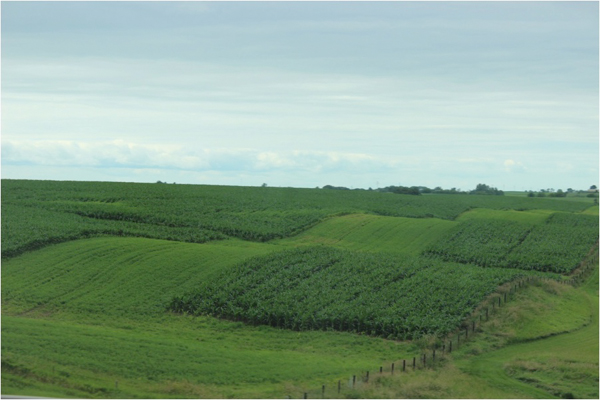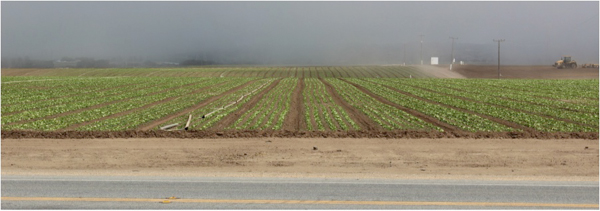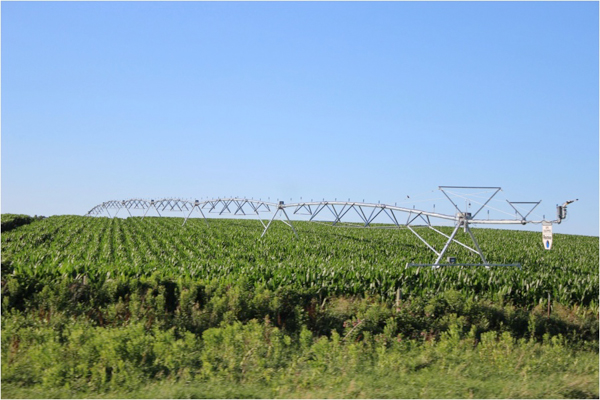 Cornfields in Iowa. Photo credit: David Gonthier.
Cornfields in Iowa. Photo credit: David Gonthier.
To protect natural ecosystems in the long term, some conservationists advocate "land sparing," in which farmers intensify agricultural practices to boost yields, theoretically enabling them to forgo expansion into natural areas. Others advocate "land sharing," in which farmers take over more land but use low-intensity, more environmentally friendly agricultural practices.
High-intensity practices on land-sparing farms, such as heavy planting, grazing, and use of fertilizer and pesticides, can threaten native species with small home ranges, while land-sharing farms can chip away at the size of the surrounding natural landscape and degrade its quality, threatening more widely ranging native species.
So what’s a farmer, or a conservationist, to do? Until now, there has been no broad-scale study of the relative effects of local versus landscape-level management approaches on biodiversity.
To fill the gap, David Gonthier, now a postdoctoral fellow in environmental science at the University of California, Berkeley, and several colleagues compiled data from 31 studies carried out on North American and European farms to assess how the diversity and abundance of plant, invertebrate, and vertebrate species are affected by local agricultural practices and by the composition of the surrounding landscape.
In a study in Proceedings of the Royal Society B, the researchers report an average of 40 percent greater diversity of plants, invertebrates, and vertebrates at farms with low-intensity management practices than at farms with higher-intensity practices. In particular, low-intensity farms had 92 percent greater plant diversity and 21 percent greater invertebrate diversity than high-intensity farms. Vertebrates showed no significant difference between high- and low-intensity farms.

Vegetables grow in Salinas, California. Photo credit: David Gonthier.
This finding supports claims by environmentalists that biodiversity on farms can be improved through low-intensity agricultural practices, such as reducing pesticide and fertilizer use, adding hedgerows, and reducing planting and grazing densities, Katherine Ennis, a doctoral student at the University of California Santa Cruz who co-authored the paper, told mongabay.com.
In fact, it’s a win-win. Plant and invertebrate diversity, in turn, are good for farms. Some of the weedy plants that farmers try to kill with herbicides may have high conservation value. Maintaining diverse plant life on a farm can help stabilize soil structure and increase nutrient availability, as well as provide shelter for pest-controlling insects. And farmers may not realize that killing crop-damaging insects with pesticides may also reduce beneficial invertebrates on their farms and beyond. For example, bees, spiders, and certain beetles provide important pollination and natural pest-control services for farms.
As for the effect of the landscape as a whole on biodiversity, two-thirds of the papers reviewed in the study showed a greater diversity of invertebrates and vertebrates on farms located in "complex" landscapes containing a variety of natural habitat types than on farms located in simpler landscapes. There was no significant relationship between plant diversity and landscape complexity.
"Our research suggests that the farm level management changes are important, but the larger, regional conservation of forest fragments and natural areas may be equally as important — especially for the conservation of vertebrate species and more mobile species," Ennis said.
In short, land sparing and land sharing may be two sides of the same coin. The authors argue that it is important to establish a more holistic conservation agenda that includes both local and landscape strategies: both helping farmers adopt wildlife-friendly practices as well as protecting surrounding natural ecosystems.

Cornfields in Kansas. Photo credit: David Gonthier.
That’s not always easy. Gonthier told mongabay.com that improving farming practices “may require resources, knowledge and time to implement,” that many farmers don’t have.
And landscape-level conservation is no walk in the park, either. “Conservation at regional scales is more difficult to adopt than at the farm level because it requires greater cooperation amongst multiple stakeholders,” Ennis said.
To overcome these challenges, Gonthier said he believes that governments and other groups can “help incentivize farmers to implement ‘wildlife-friendly’ practices within fields and help neighboring landowners cooperate to [manage] landscapes together.”
Ultimately, it may take a mix of land sharing and sparing to meet growing consumer demands and conservation priorities.
Citations:
-
Gonthier DJ, Ennis K. K., Farinas S., Hsieh H. Y., Iverson A. L., Batáry P., Rudolphi J., Tschamtke T., Cardinale B. J., and Perfecto I. (2014.) Biodiversity conservation in agriculture requires a multi-scale approach. Proc. R. Soc. B 281 20141358; DOI: 10.1098/rspb.2014.1358
}}